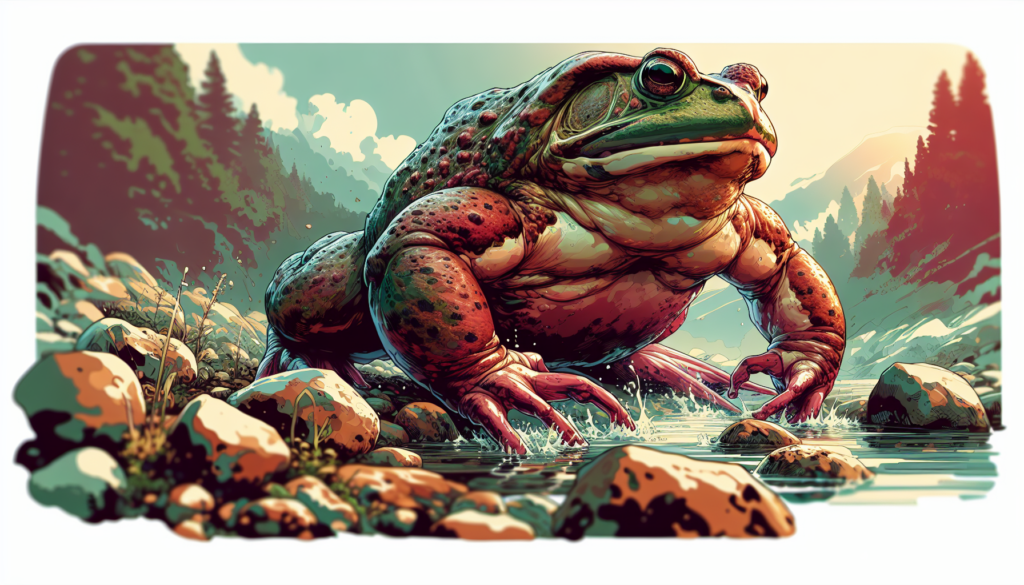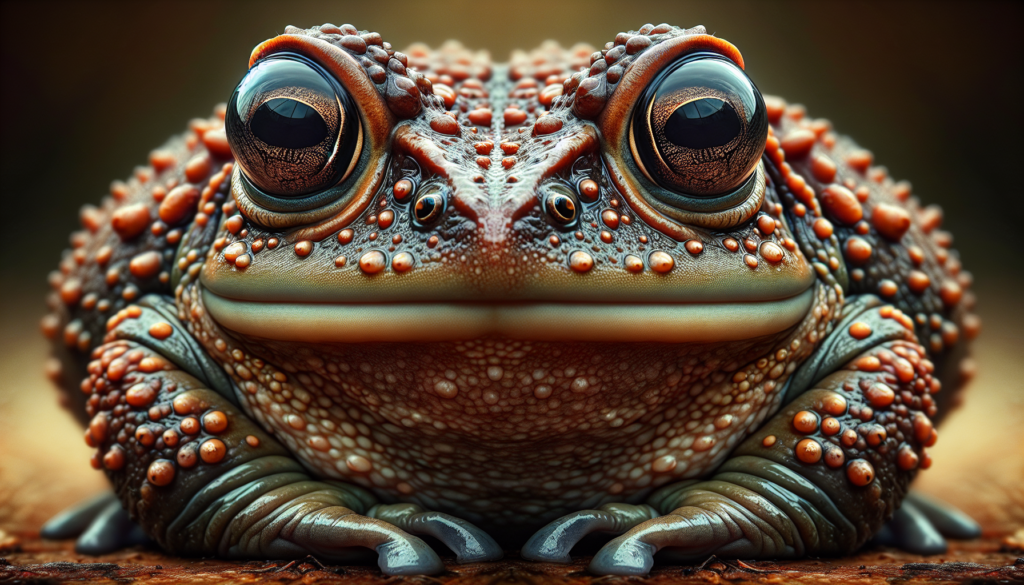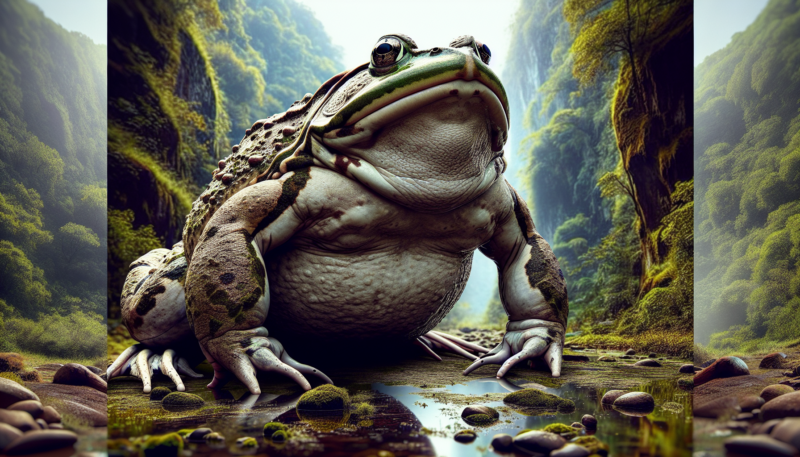Have you ever marveled at the impressive size of bullfrogs? These amphibious creatures are known for their remarkable dimensions that leave people in awe. With their powerful bodies and sturdy legs, bullfrogs can grow to be one of the largest species of frogs in the world. From their relentless appetite to their distinct vocalizations, there is much to be fascinated by when it comes to the remarkable size of bullfrogs.

Physical Appearance
Color
Bullfrogs are known for their vibrant and eye-catching colors. They typically have a rich green or olive-colored body, which blends perfectly with their natural environment. Their backs are adorned with dark spots or blotches, adding a unique touch to their appearance. However, it is essential to note that bullfrog coloration can vary depending on factors such as age, environment, and individual genetic variation.
Body Structure
When it comes to body structure, bullfrogs are built for success in their amphibious lifestyles. They have a robust and muscular body with strong hind legs that allow them to leap impressive distances. Their front legs are shorter and adapted for digging and gripping. Bullfrogs also possess powerful jaws, equipped with sharp teeth, making them formidable predators in their habitats. On average, adult bullfrogs can measure around 3 to 6 inches in length, excluding their hind legs.
Size Comparison
Length
Bullfrogs are known for their substantial size, especially when compared to other frog species. On average, adult bullfrogs can reach lengths of 3 to 6 inches, excluding their hind legs. However, it’s important to note that certain bullfrog species can grow even larger, reaching remarkable lengths of up to 8 inches or more. These impressive dimensions set bullfrogs apart as some of the largest frogs in the world.
Weight
The size of bullfrogs not only relates to their length but also their weight. Adult bullfrogs can weigh anywhere between 0.5 to 1.5 pounds, with some exceptional individuals tipping the scales at over 2 pounds. These weighty measurements highlight the substantial mass that bullfrogs can achieve, showcasing their impressive growth potential.
Largest Bullfrog Species
Goliath Frog
When discussing the largest bullfrog species in the world, the Goliath Frog undoubtedly takes the crown. Native to the rainforests of Central and West Africa, these incredible frogs can grow up to a colossal length of 12.6 inches and weigh a staggering 7.2 pounds or more. The Goliath Frog’s mammoth size earns it the well-deserved title of the world’s largest frog, captivating the attention and curiosity of nature enthusiasts around the globe.
African Bullfrog
Another notable contender for a record-breaking bullfrog species is the African Bullfrog. This robust amphibian is indigenous to various regions of sub-Saharan Africa. Growing up to 10 inches in length and weighing approximately 2 pounds, the African Bullfrog holds its own when it comes to sheer size. These impressive amphibians display fascinating behaviors and make a significant impact on their surrounding ecosystems.
Diet
Bullfrogs are voracious carnivores and have a reputation for being skilled predators. Their diet consists mainly of insects, small fish, crustaceans, and even baby birds or mammals. With their powerful jaws and lightning-quick reflexes, bullfrogs can swiftly snap up their prey with remarkable precision. Vocalization, discussed later, also plays a crucial role in bullfrogs attracting prey. This diverse diet ensures that bullfrogs obtain the necessary nutrients to support their growth and maintain their energy levels.

Habitat
Bullfrogs have a broad habitat range, which contributes to their success as a species. They can be found in various freshwater environments, such as ponds, lakes, swamps, marshes, and slow-moving rivers. These adaptable amphibians are capable of thriving in both natural and artificial water bodies, showcasing their ability to adapt to different conditions. Bullfrogs seek out locations with ample vegetation, as this provides them with cover and opportunities to hunt for food effectively.
Lifecycle
Metamorphosis
Like all frogs, bullfrogs undergo a fascinating metamorphosis as they transition from tadpoles to full-fledged adults. After hatching from their eggs, bullfrog larvae, also known as tadpoles, spend their early stages of life in the water. They gradually develop and grow, utilizing their specialized tails for swimming and feeding on algae and plant matter. As they mature, the tadpoles gradually develop limbs, absorb their tails, and eventually emerge from the water as juvenile bullfrogs.
Breeding
Bullfrogs exhibit unique breeding behaviors that contribute to their success as a species. During the breeding season, which typically occurs in spring or early summer, males produce distinctive loud calls to attract females. These vocalizations, often described as deep, resonating “jug-o-rum” or “rumph,” can be heard over long distances. Once the female accepts a specific male’s courtship, she lays her eggs in shallow water or vegetation, where they develop into tadpoles.

Behavior
Territoriality
Bullfrogs are known for their territorial nature. They defend their chosen areas from other frogs, especially during the breeding season. Male bullfrogs are particularly territorial and establish their dominance by vocalizing and physically interacting with potential competitors. This territorial behavior ensures that each male has access to suitable breeding sites and maximizes their chances of successfully reproducing.
Vocalization
Vocalization is a crucial aspect of bullfrog behavior, serving various purposes throughout their lives. Males produce loud and distinctive calls to attract females during the breeding season, as mentioned earlier. Additionally, bullfrogs engage in vocalization to assert their dominance and mark their territories, warning neighboring males to stay away. The unique sounds emitted by bullfrogs during these vocal displays contribute to the ambiance of wetland environments and are a captivating aspect of their overall behavior.
Predators
Despite their impressive size and strength, bullfrogs are not invincible in their natural habitats. They face predation from a variety of animals, including birds of prey, larger fish, snakes, raccoons, and even other frogs. Many predators are attracted to bullfrogs due to their substantial size and abundant energy reserves, providing a substantial meal. However, bullfrogs’ adaptability and defensive behavior, such as their territoriality, play a vital role in reducing predation rates.

Conservation Status
Invasive Species
While bullfrogs may be admired for their charismatic appearance and fascinating behaviors, their presence in various regions outside their natural range has raised concerns regarding conservation. Bullfrogs have been introduced into non-native habitats through human activity, leading to their classification as invasive species. Invasive bullfrog populations can have detrimental effects on native wildlife, as they compete for resources and may prey upon smaller frog species. Conservation efforts aim to address these issues and protect the delicate balance of ecosystems affected by invasive bullfrogs.
Human Interaction
Hunting
Bullfrogs have been hunted for various reasons throughout history, primarily for their meat and as a source of frog legs for culinary purposes. In some cultures, bullfrog legs are considered a delicacy and are sought after for their unique taste and texture. However, sustainable and regulated hunting practices are necessary to ensure that bullfrog populations are not overexploited, thus preserving their presence in their natural habitats.
Pet Trade
Bullfrogs are also popular in the pet trade industry, where individuals may be kept as pets, often in specially designed aquariums. Due to their large size and specific care requirements, bullfrogs are more commonly sought after by experienced amphibian enthusiasts. However, it is crucial for potential owners to research and understand the responsibilities associated with keeping bullfrogs as pets, including providing suitable habitats, proper nutrition, and an environment that mimics their natural conditions.
In conclusion, bullfrogs are fascinating creatures, captivating observers with their impressive physical appearance, unique behaviors, and ability to thrive in diverse habitats. Despite facing challenges such as predation, invasive species concerns, and human interactions, bullfrogs continue to enchant and spark curiosity. Their contributions as both predator and prey play an integral role in maintaining ecological balance in their respective ecosystems. By understanding and appreciating these incredible amphibians, we can ensure the conservation of bullfrog populations for future generations to admire and study.
